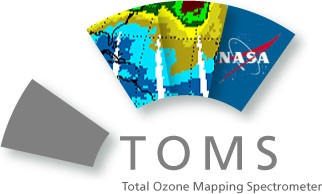
TOMS

Introduction
TOMS is an atmospheric sensor focusing on ozone retrieval. It has been operating on different NASA missions since November 1978.
The objective is to continue global ozone monitoring
that began in 1978 with the launch of TOMS on NIMBUS-7. Together with
TOMS on METEOR-3 a complete and consistent data set of daily total column
ozone is provided till December 1994. After an 18 month data gap ADEOS
TOMS was launched in July 1996 delivering data until June 1997. Earth
Probe TOMS was launched in July 1996 as well, but continues to provide
near-real-time data and observation of the Antarctic ozone hole as well
as sulfur dioxide resulting from volcanic eruptions.
TOMS is a nadir looking instument that measures the albedo of the Earths
atmosphere at six narrow spectral bands in the near-ultraviolet region.
The albedo is measured by comparing the radiance of the Earth with the
radiance of a calibrated diffuser plate. Total ozone is derived from the
differential albedo in three pairs of spectral bands, which are selected
to allow for an accurate retrieval at all latitudes and solar illumination
conditions.
Available Data
- Here you can download TOMS ozone data within one hour after processing at NASA.
- See the DLR near real time Level 3 products (Ozone maps for Europe, Southpole, Northpole and global)
- Browse the NASA TOMS data archive
- Browse the WDC TOMS data archive
- Earth Probe TOMS
- Adeos TOMS
- Meteor-3 TOMS
- Nimbus-7 TOMS
Links to further information
- TOMS general and additional information can be found at the NASA's TOMS homepage at GSFC.
- See the NASA Facts page on TOMS History
- General information about TOMS you can get at BADC (British Atmospheric Data Centre).
- The TOMS Volcanic SO2 and Ash Homepage you can find at NASA's GSFC.
- For TOMS aerosol products please click here.
- Latest information on the instrument can be found on the news
page.
Contact
For more information please contact wdc@dlr.de.